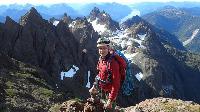The purpose of this article is to point out some very important and timeless principles of safety for hikers in the Drakensberg Mountains.
The "Take Care in the Mountains" brochure, available at Ezemvelo KZN Wildlife offices in the Berg is an often overlooked piece of paper, which outlines some very important points on hiking safety. These may be forgotten, or even seem overly cautious, especially when the Berg enchants it's visitors with its splendour and apparent calmness, but which take on vivid reality when the Dragon of these mountains changes it's mood into something more fierce and foreboding, something which often happens with very little warning.
The following information has been adapted from the KZN Wildlife site. The original version can be read here.
Most Important: Make sure you fill in the Hiking Register with the details of your party and the route you intend to follow. In the event of a problem it will be possible to find you and lend support or institute a rescue.
The five day forecast for the berg can be obtained by calling 082 2311 602.
In the interests of public safety, Ezemvelo KZN Wildlife would like to advise all people intending to walk or hike in the uKhahlamba-Drakensberg Park World Heritage Site, to be aware of certain safety requirements. Members of the public wishing to hike in the uKhahlamba-Drakensberg Park are advised to contact the Ezemvelo KZN Wildlife office nearest their intended point of entry to ascertain what the current security situation is in that area, as well as to enquire about anticipated or prevailing weather conditions.
Ezemvelo KZN Wildlife further cautions visitors to hike in groups of no less than four, and advises that no hikers should venture along the high Drakensberg escarpment unless they have experience of that region or have an appropriately experienced person in their party.
In a party of four, should one member suffer an immobilising injury, one person can stay with the injured person while two people go for help, thus considerably improving the safety margin for both parties. All hikers, whether they be on a day walk or an overnight hike should properly and clearly fill in the day-walk and Mountain Rescue registers. These are to be found at all Ezemvelo KZN Wildlife offices in the Park or at other points of entry such as the Sentinel car park near the Royal Natal Amphitheatre or the Mweni area between Cathedral Peak and Royal Natal.
Mountain Rescue Registers for the Mnweni area are to be found at the office of the Mnweni Cultural Centre. Information in these registers becomes vital in the event of an accident befalling a hiker, as the rescue team can use the information to effect a more rapid rescue operation. In the case of hikers becoming lost, the search teams can use information from the Mountain Rescue Register to plan a more effective search. Hikers should enter their details legibly and as completely as possible as to do so can make the difference between life and death.
Two pamphlets giving brief tips on hiking the Drakensberg are available free of charge from Ezemvelo KZN Wildlife offices in the uKhahlamba-Drakensberg Park, and reasonably priced but highly detailed hiking maps are also available. Several excellent books on Drakensberg hiking also provide valuable information for the would-be hiker and are available at bookstores and at some Ezemvelo KZN Wildlife outlets.
Hiking rules for everyone's benefit
Your behaviour in the Park or Nature Reserve can help maintain the beauty and ecology of the area. Here is some information that can make everyones hikeing more pleasant.
1. The mountains are littered with cairns, most of them meaningless or misleading except to the original builders. Do not spoil the wilderness experience of others by building cairns or, even worse, by defacing rocks and overhangs. Learn to read the map and if you must mark the way for stragglers in the party, use the simple boy scout trick of one stone on top another and ensure the last person in the party knocks the markers down.
2. Don’t be tempted to leave your name, messages or arrows on any rocks or trees - please leave them in the visitor’s book.
3. Please keep your litter with you until you reach an entry point or home. Don’t throw away items, even if they will break down quickly. Don’t throw away your cigarette ends. Help us by picking up the litter that you encounter.
4. Please consider the other users of the mountains. Preferably defecate in the grasslands, at least five minutes walk from streams, caves, paths and forests.
5. Unscheduled fires are devastating to the animals and plants: to reduce the risk of accidents, no fires are allowed. This applies to all caves too. Only the use of camping stoves is allowed.
6. The Drakensberg is one of the richest sites of rock art in the world. This precious resource of international archeological value. Do not touch, wet, trace or interfere with rock art in any way. Report anybody who you see doing such actions to the nearest KZN Wildlife office.
7. Stick to the paths constructed for your use. Leaving them will case unnecessary erosion: please don’t take short cuts.
8. Do not pick the flowers - enable everyone to enjoy them and allow them to produce seeds.
9. Most people visit the Drakensberg to enjoy the peace it offers. Do not make noise.
10. Take extreme care not to dislodge rocks as they endanger the lives of others, damage vegetation and even start erosion.
11. Remember to tell someone who knows where you are going. Fill in the day-walk register where one is available.
12. Watch the weather as it can change quickly. Always carry water and warm waterproof clothing with you.
13. Don’t feed any wild animals as this makes them problem animals which may have to be destroyed.
14. Don’t kill snakes. They play an important role in the ecology of the park.
15. Report all emergencies to the nearest KZN Wildlife office.
16. Report any misbehaviour and offences to a KZN Wildlife employee.
Security
When camping on or near the escarpment, beware of the theft of backpacks and equipment by local herdsmen/shepherds. These thefts usually occur at night and result in boots and backpacks being pulled out from under the fly sheets of tents. There are several ways to make camping safer in the high Berg. One way is simply not to be seen by shepherds and to camp in secluded valleys or behind ridges. Theft usually happens at popular camping spots. If near a Basotho kraal, one good precaution is to approach the dwelling and speak to the owner. Ask if you may camp nearby or even next to the kraal. Striking up a freindship with the person goes a long way to prevent theft. Staying in caves is probably safer than in tents. Theft is less likely to happen below the escarpment.
Rescue Procedure
In the event of an accident or death, the nearest ranger should be notified as soon as possible. The rescue call will be made by the ranger. Failing this contact the MCSA. As a last resort phone 10177 or 0800 005133 and explain to the operator that it is a Mountain Rescue Emergency. Before reporting the accident, the reporting party should note:
1. the exact location
2. any patient injuries
3. the time when the accident occurred
4. the state of the patient when last seen
5. what equipment and clothing the patient has with them
6. whether technical gear would be needed to reach the patient
7. any particular medical problems
8. what First Aid has already been administered
9. what the present weather conditions are
10. patient's name, gender and age.
Medical and Rescue emergencies in the Drakensberg fall under the authority of the Provincial Emergency Medical Rescue Service (EMRS). However, due to the hazards and technical difficulties encountered in the Berg, rescues are usually carried out by the Kwa-Zulu Natal Section of the Mountain Club of South Africa. This highly efficient and well-equipped rescue team is supported by helicopters from the South African Air Force, 15 Squardron and the SAPS Airwing. SAPS K9 Rescue dogs are also used in search operations. The Mountain Club of SA has a proud tradition in mountain Search and Rescue, spanning some 80 years. Rescue team members are all volunteers and spend many hours annually practising rescue skills.



